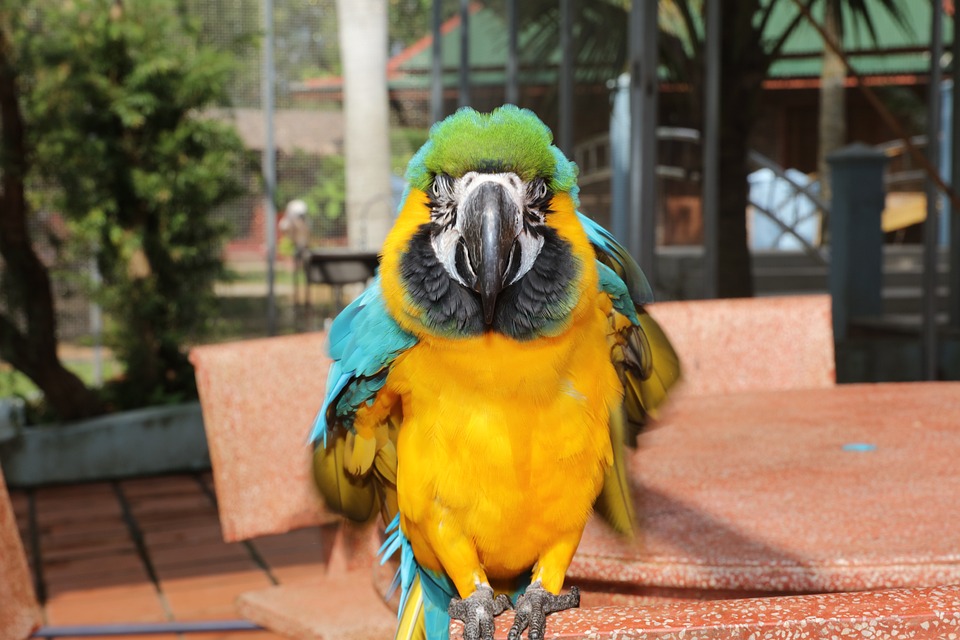**Header: How to Teach Your Parrot to Kiss or Give Affection: A Comprehensive Guide**
**Introduction: Building a Loving Bond with Your Parrot**
Parrots are known for their vibrant personalities and ability to mimic human speech, but they can also develop deep emotional connections with their owners. Teaching your parrot to give affection, such as kisses, not only strengthens your bond but also provides mental stimulation for your feathered friend. In this article, we will explore effective techniques to train your parrot to kiss and answer some frequently asked questions about parrot training.
**Section 1: The Importance of Positive Reinforcement in Parrot Training**
Positive reinforcement is crucial in parrot training as it helps to establish a positive association with desired behaviors. By rewarding your parrot with treats, praises, or other positive stimuli when they exhibit the desired behavior, you motivate them to continue performing it. Additionally, positive reinforcement helps to build trust and mutual respect between you and your parrot.
**Section 2: Preparing the Training Environment**
Creating a safe and comfortable space for training is essential to ensure your parrot’s focus and success. Remove any potential hazards or distractions from the training area to minimize accidents or interruptions. Providing a calm and quiet environment will allow your parrot to concentrate on the training session.
**Section 3: Step-by-Step Guide to Teach Your Parrot to Kiss**
Step 1: Developing a Cue for Affection
Choose a specific cue, such as a word or a gesture, that you will use to indicate that you want your parrot to give you a kiss.
Step 2: Target Training for Kissing Behavior
Introduce a target, such as a stick or your finger, and teach your parrot to touch it with their beak. This step helps them understand the concept of targeting and prepares them for the kissing behavior.
Step 3: Pairing the Cue with the Behavior
Once your parrot is comfortable with target training, begin associating the cue for affection (e.g., saying “kiss”) with the act of touching the target with their beak.
Step 4: Rewarding and Reinforcing the Desired Behavior
Whenever your parrot successfully performs the kissing behavior, immediately reward them with treats, praises, or other positive reinforcement. Consistency in rewarding will strengthen the association between the cue and the behavior.
**Section 4: Common Challenges in Parrot Training**
Biting or Nipping During Training
If your parrot displays aggressive behavior during training, it is important to address it promptly. Seek guidance from a professional avian behaviorist to understand the underlying causes and implement appropriate counter-conditioning techniques.
Lack of Interest or Motivation
If your parrot seems disinterested in training, try using different types of rewards, such as their favorite treats or toys, to increase their motivation. Additionally, vary the training sessions to keep them engaging and exciting for your parrot.
Overcoming Fear or Anxiety
If your parrot exhibits fear or anxiety during training, it is crucial to create a safe and supportive environment. Gradually introduce new stimuli or situations, and always respect your parrot’s comfort zone. Patience and gentle encouragement will help them overcome their fears.
**FAQs: Frequently Asked Questions about Parrot Training**
1. Q: Can all parrot species be trained to give kisses?
Different parrot species have varying aptitudes for affection training. While some species are more inclined to learn and exhibit affectionate behaviors, others may require more time and patience. Research your specific parrot species to understand their natural tendencies and adapt your training techniques accordingly.
2. Q: How long does it typically take to teach a parrot to kiss?
The time it takes to teach a parrot to kiss can vary depending on the individual bird and their willingness to learn. Patience and consistency are key. Some parrots may learn the behavior within a few weeks, while others may take several months.
3. Q: Are there any risks involved in training a parrot to kiss?
When training your parrot to give kisses, it is important to ensure their safety. Avoid any forceful or aggressive behaviors that may cause stress or harm to your parrot. Always monitor their body language and responses during training to prevent any injuries.
4. Q: Can parrots learn to give kisses on command?
With consistent training, parrots can learn to give kisses on command. Once your parrot has grasped the concept of the behavior, you can introduce a specific command or cue that signals them to perform the kissing behavior.
5. Q: What if my parrot doesn’t seem interested in giving kisses?
Every parrot has a unique personality, and some may not be as inclined to give kisses as others. Tailor your training methods to suit your parrot’s preferences and focus on other affectionate behaviors they may be more comfortable with, such as cuddling or preening.
**Conclusion: Strengthening Your Bond with Affectionate Training**
Training your parrot to give kisses or affectionate gestures not only deepens your relationship but also enhances the overall well-being of your feathered companion. By using positive reinforcement techniques and providing a nurturing environment, you can create a loving bond that will last a lifetime. Remember to be patient, consistent, and always prioritize your parrot’s safety and comfort. Enjoy the journey of building a strong connection with your parrot through affectionate training!









